Lignin Pellets for Advanced Thermochemical Process—From a Single Pellet System to a Laboratory-Scale Pellet Mill
Abstract
1. Introduction
2. Materials and Methods
2.1. Raw Material
2.2. Experimental Setup
2.2.1. Single Pellet System
- -
- A temperature control and heating system were implemented on the system;
- -
- A sensor was added on the bench to monitor compression pressure during the process.
2.2.2. Laboratory-Scale Pellet Mill
2.3. Properties of Pellets
2.3.1. Moisture Content
2.3.2. Dimensions
- -
- For the length, each end of the micrometer was positioned at both ends of the pellets;
- -
- For the diameter, three measures were gathered: the first one in the center as well as two more from each end of the pellets.
2.3.3. Impact Resistance
2.3.4. Water Resistance
2.3.5. Fines Content
2.3.6. Mechanical Durability
2.3.7. Calorific Value
2.3.8. Ash Content
2.3.9. Carbon, Hydrogen, and Nitrogen Content
2.3.10. Sulfur Content
2.4. Additives
3. Results and Discussion
3.1. Properties of a Raw Material
3.2. Thermogravimetric Image of the Experimental Setup
3.3. Pellets Properties from a Single Pellet System
3.4. Pelles Properties from a Laboratory-Scale Pellet Mill—Scenario 1
3.5. Pellets Properties from a laboratory-Scale Pellet Mill—Scenario 2 (Additives)
4. Conclusions
Author Contributions
Funding
Data Availability Statement
Acknowledgments
Conflicts of Interest
References
- Stelte, W.; Sanadi, A.; Shang, L.; Holm, J.; Ahrenfeldt, J.; Henriksen, U. Recent developments in biomass pelletization—A review. Bioresources 2012, 7, 4451–4490. [Google Scholar] [CrossRef]
- Obernberger, I.; Thek, G. The Pellet Handbook: The Production and Thermal Utilisation of Biomass Pellets; Earthscan Ltd.: London, UK, 2010. [Google Scholar]
- CANplus Certification: Part 3: Pellet Quality Requirements. Version 3; Wood Pellet Association of Canada: Revelstoke, BC, Canada, 2016; Available online: www.pellet.org (accessed on 18 May 2019).
- Sah, P.; Singh, B.; Agrawal, U. Compaction behavior of straw. J. Agric. Eng. India 1980, 18, 89–96. [Google Scholar]
- Khankari, K.K.; Shrivastava, M.; Morey, R.V. Densification Characteristics of Rice Hulls. ASAE Paper No. 89-6093. 1989. Available online: https://agris.fao.org/agris-search/search.do?recordID=US9183525 (accessed on 15 June 2021).
- Shrivastava, M.; Shrivastava, P.; Khankari, K.K. Densification characteristic of rice husk under cold and hot compression. In Proceedings of the 11th International Congress on Agricultural Engineering, Dublin, Ireland, 4–8 September 1989. [Google Scholar]
- Al-Widyan, M.I.; Al-Jalil, H.F. Stress-density relationship and energy requirement of compressed olive cake. Appl. Eng. Agric. 2001, 17, 749–753. [Google Scholar] [CrossRef]
- Richards, S.R. Physical testing of fuel briquettes. Fuel Process. Technol. 1990, 25, 89–100. [Google Scholar] [CrossRef]
- Lindley, J.A.; Vossoughi, M. Physical properties of biomass briquettes. Power Mach. ASAE 1989, 32, 361–366. [Google Scholar] [CrossRef]
- Lee, J.S.; Sokhansanj, S.; Lau, A.K.; Lim, C.J. Physical properties of wood pellets exposed to liquid water. Biomass Bioenergy 2020, 142, 105748. [Google Scholar] [CrossRef]
- Dyjakon, A.; Noszczyk, T. The influence of freezing temperature storage on the mechanical durability of commercial pellets from biomass. Energies 2019, 12, 2627. [Google Scholar] [CrossRef]
- Lee, J.S.; Sokhansanj, S.; Lau, A.K.; Lim, C.J.; Bi, C.T.; Basset, V.; Yazdanpanah, F.; Melin, S. The effects of long term storage on the net calorific value of wood pellets. Can. Biosyst. Eng. 2015, 57, 5–12. [Google Scholar] [CrossRef]
- Takada, M.; Chandra, R.; Wu, J.; Saddler, J.N. The influence of lignin on the effectiveness of using a chemithermomechanical pulping based process to pretreat softwood chips and pellets prior to enzymatic hydrolysis. Bioresour. Technol. 2020, 302, 122895. [Google Scholar] [CrossRef]
- Lam, P.S.; Sokhansanj, S.; Bi, X.; Lim, C.J.; Melin, S. Energy input and quality of pellets made from steam-exploded Douglas fir (Pseudotsuga menziessi). Energy Fuels 2011, 25, 1521–1528. [Google Scholar] [CrossRef]
- Rudolfsson, M.; Stelte, W.; Lestander, T.A. Process optimization of combined biomass torrefaction and pelletization for fuel pellet production—A parametric study. Appl. Energy 2015, 140, 378–384. [Google Scholar] [CrossRef]
- Frodeson, S.; Henriksson, G.; Berghel, J. Pelletizing pure biomass substances to investigate the mechanical properties and bonding mechanisms. BioResources 2018, 13, 1202–1222. [Google Scholar] [CrossRef]
- ISO 3310-2:2013; Test sieves—Technical requirements and testing. International Organization for Standardization: Geneva, Switzerland, 2013.
- Stevens, J.; Gardner, D. Enhancing the Fuel Value of Wood Pellets with the Addition of Lignin. Wood Fiber Sci. 2010, 42, 439–443. [Google Scholar]
- Stelte, W.; Holm, J.K.; Sanadi, A.R.; Barsber, S.; Ahrenfeldt, J.; Henriksen, U. B: Fuel pellets from biomass: The importance of the pelletizing pressure and its dependency on the processing conditions. Fuel 2011, 90, 3285–3290. [Google Scholar] [CrossRef]
- Berghel, J.; Frodeson, S.; Granstrom, K.; Renstrom, R.; Stahl, M.; Nordgren, D.; Tomani, P. The effects of kraft lignin additives on wood fuel pellet quality, energy use and shelf life. Fuel Process. Technol. 2013, 112, 64–69. [Google Scholar] [CrossRef]
- Tarasov, D.; Shahi, C.; Leitch, M. Effect of Additives on Wood Pellet Physical and Thermal Characteristics: A Review. ISRN For. 2013, 6, 1–6. [Google Scholar] [CrossRef]
- Zafari, A.; Kianmehr, M.H. Effect of raw material properties and die geometry on the density of biomass pellets from composted municipal waste. Bioresources 2012, 7, 4704–4714. [Google Scholar] [CrossRef][Green Version]
- Peng, J.H.; Bi, H.T.; Lim, C.J.; Sokhansanj, S. Study on Density, Hardness, and Moisture Uptake of Torrefied Wood Pellets. Energy Fuels 2013, 27, 967–974. [Google Scholar] [CrossRef]
- Tumuluru, J.S. Effect of process variables on the density and durability of the pellets made from high moisture corn stover. Biosyst. Eng. 2014, 119, 44–57. [Google Scholar] [CrossRef]
- Tumuluru, J.S. Specific energy consumption and quality of wood pellets produced using high-moisture lodgepole pine grind in a flat die pellet mill. Chem. Eng. Res. Des. 2016, 110, 82–97. [Google Scholar] [CrossRef]
- Monedero, E.; Portero, H.; Lapuerta, M. Pellet blends of poplar and pine sawdust: Effects of material composition, additive, moisture content and compression die on pellet quality. Fuel Processing Technol. 2015, 132, 15–23. [Google Scholar] [CrossRef]
- Civitarese, V.; Acampora, A.; Sperandio, G.; Assirelli, A.; Picchio, R. Production of wood pellets from poplar trees managed as coppices with different harvesting cycles. Energies 2019, 12, 2973. [Google Scholar] [CrossRef]
- Goring, D.I.A. Thermal softening of lignin, hemicelluloses and cellulose. Pulp Pap. Mag. Can. 1963, 64, 517–527. [Google Scholar]
- Goring, D.I.A. Thermal softening, adhesive properties and glass transitions in lignin, hemicellulose and cellulose. In Consolidation of the Paper Web; FRC: Manchester, UK, 1965; pp. 555–568. [Google Scholar]
- Back, E.L.; Lennar Salmén, N. Glass transition of wood components hold implications for molding and pulping processes. Tappi J. Tech. Assoc. Pulp Pap. Ind. 1982, 35, 107–110. [Google Scholar]
- Kelley, S.S.; Rials, T.G.; Glasser, W.G. Relaxation behavior of the amorphous components of wood. J. Mater. Sci. 1987, 22, 6174–6624. [Google Scholar] [CrossRef]
- Lu, J.Z.; Wu, Q.; Negulescu, I.I. Surface and interfacial characterization of wood-PVC composites: Thermal and dynamic mechanical properties. Wood Fiber Sci. 2004, 36, 500–510. [Google Scholar]
- Nielsen, N.P.K.; Gardner, D.; Holm, J.K.; Tomani, P.; Felby, C. The effect of lignoboost kraft lignin addition on the pelleting properties of pine sawdust. In Proceedings of the Worlds Bioenergy Conference and Exhibition on Biomass for Energy, Jönköping, Sweden, 27–29 May 2008; Volume 5, pp. 120–124. [Google Scholar]
- Nielsen, N.P.K.; Gardner, D.J.; Poulsen, T.; Felby, C. Importance of temperature, moisture content, and species for the conversion process of wood residues into fuel pellets. Wood Fiber Sci. 2009, 41, 414–425. [Google Scholar]
- Nielsen, N.P.K.; Gardner, D.J.; Felby, C. Effect of extractives and storage on the pelletizing process of sawdust. Fuel 2010, 89, 94–98. [Google Scholar] [CrossRef]
- Stelte, W.; Clemons, C.; Holm, J.K.; Ahrenfeldt, J.; Henriksen, U.B.; Sanadi, A.R. Fuel pellets from wheat straw: The effect of lignin glass transition and surface waxes on pelletizing properties. Bioenergy Res. 2012, 5, 450–458. [Google Scholar] [CrossRef]
- Antoniow, J.S.; Maigret, J.-E.; Jensen, C.; Trannoy, N.; Chirtoc, M.; Beaugrand, J. Glass-transition temperature profile measured in a wood cell wall using scanning thermal expansion microscope (SThEM). Int. J. Thermophys. 2012, 33, 2167–2172. [Google Scholar] [CrossRef]
- Baker, D.A.; Hosseinaei, O. High Glass Transition Lignins and Lignin Derivatives for the Manufacture of Carbon and Graphite Fibers. United States. Patent Application Publication. Available online: https://app.dimensions.ai/details/patent/US-20140271443-A1 (accessed on 1 April 2021).
- Hosseinaei, O.; Harper, D.P.; Bozell, J.J.; Rials, T.G. Improving processing and performance of pure lignin carbon fibers through hardwood and herbaceous lignin blends. Int. J. Mol. Sci. 2017, 18, 1410. [Google Scholar] [CrossRef] [PubMed]
- Sadatnezhad, S.H.; Khazaeian, A.; Sandberg, D.; Tabarsa, T. Continuous surface densification of wood: A new concept for large-scale industrial processing. Bioresources 2017, 12, 3122–3132. [Google Scholar] [CrossRef]
- ISO 18324-1:2015; Solid Biofuels—Determination of Moisture Content—Oven Dry Method. International Organization for Standardization: Geneva, Switzerland, 2015.
- ISO 17829:2015; Solid Biofuels—Determination of Length and Diameter of Pellets. International Organization for Standardization: Geneva, Switzerland, 2015.
- ASTM D440-86:2002; Standard Test Method of Drop Shatter Test for Coal. ASTM International: Conshohocken, PA, USA, 2002.
- ISO 18846:2016; Solid biofuels—Determination of Fines Content in Samples of Pellets. International Organization for Standardization: Geneva, Switzerland, 2016.
- ISO 17831-1:2015; Solid biofuels—Determination of Mechanical Durability of Pellets and Briquettes—Part 1: Pellets. International Organization for Standardization: Geneva, Switzerland, 2015.
- ISO 18125:2017; Solid biofuels—Determination of Calorific Value. International Organization for Standardization: Geneva, Switzerland, 2017.
- ISO 18122:2015; Solid biofuels—Determination of Ash Content. International Organization for Standardization: Geneva, Switzerland, 2015.
- ISO 16948:2015; Solid biofuels—Determination of Total Content of Carbon, Hydrogen and Nitrogen. International Organization for Standardization: Geneva, Switzerland, 2015.
- ISO 16994:2016; Solid biofuels—Determination of Total Content of Sulfur and Chlorine. International Organization for Standardization: Geneva, Switzerland, 2016.
- Zhang, M.; Eddy, C.; Deanda, K.; Finkelstein, M.; Picataggio, S. Metabolic engineering of a pentose metabolism pathway in ethanologenic zymomonas mobilis. Science 1995, 267, 240–243. [Google Scholar] [CrossRef] [PubMed]
- Klasnja, B.; Kopitovic, S.; Orlovic, S. Wood and bark of some poplar and willow clones as fuelwood. Biomass Bioenergy 2002, 23, 427–432. [Google Scholar] [CrossRef]
- Ebeling, J.M.; Jenkins, B.M. Physical and chemical properties of biomass fuels. Trans. ASAE 1985, 28, 898–902. [Google Scholar] [CrossRef]
- Demirbas, A. Relationship between lignin contents and heating values of biomass. Energy Convers. Manag. 2001, 42, 183–188. [Google Scholar] [CrossRef]
- Demirbas, A. Relationships between heating value and lignin, moisture, ash and extractive contents of biomass fuels. Energy Explor. Exploit. 2002, 20, 105–111. [Google Scholar] [CrossRef]
- Demirbas, A. Combustion characteristic of different biomass fuels. Prog. Energy Combust. Sci. 2004, 30, 219–230. [Google Scholar] [CrossRef]
- Klasnja, B.; Orlovic, S.; Galic, Z. Comparison of different wood species as raw materials for bioenergy. South-East Eur. For. 2013, 4, 81–88. [Google Scholar] [CrossRef]
- Melin, S. Bark as Feedstock for Production of Wood Pellets; Wood Pellet Association of Canada: Revelstoke, BC, Canada, 2008. [Google Scholar]


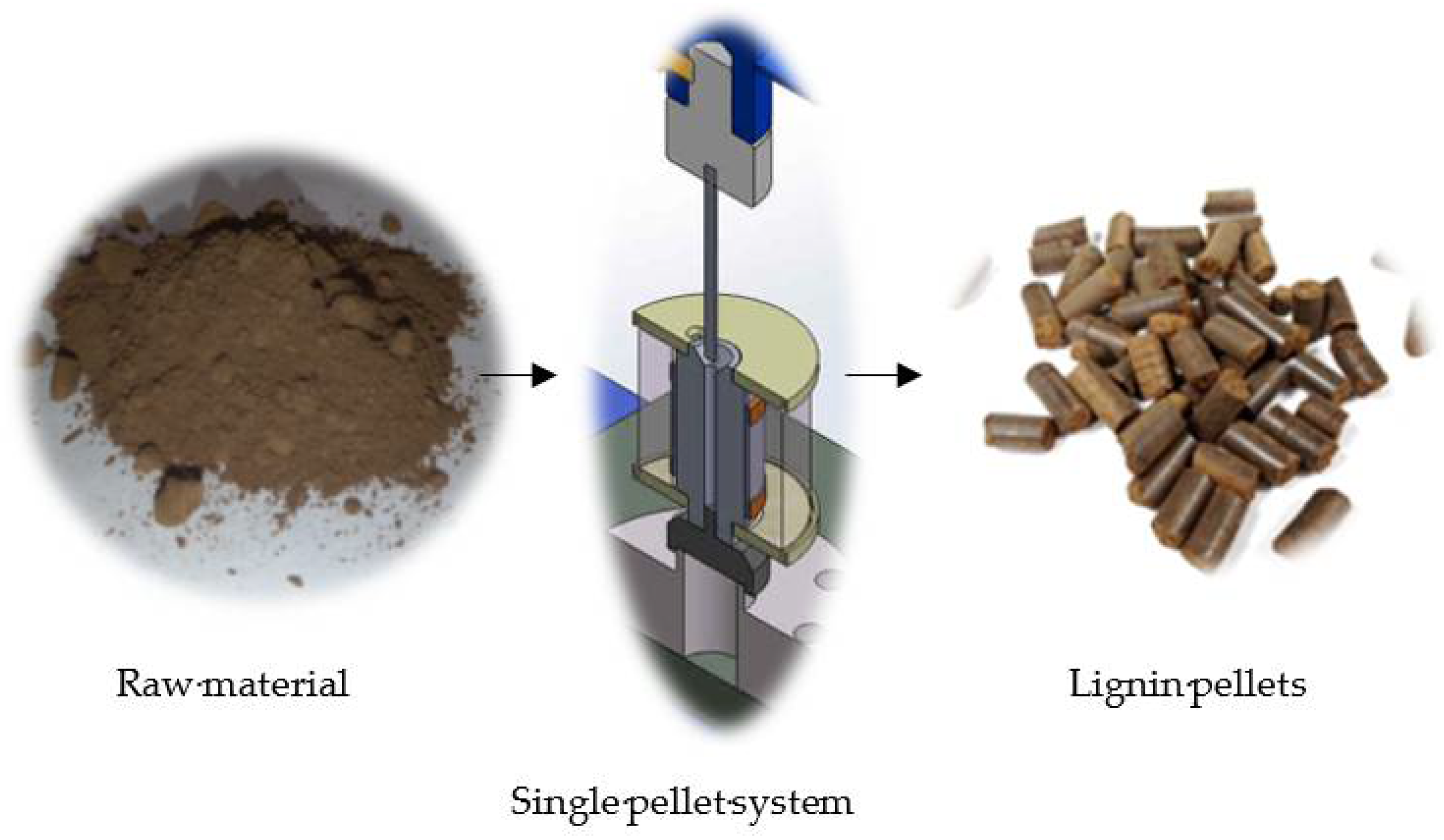

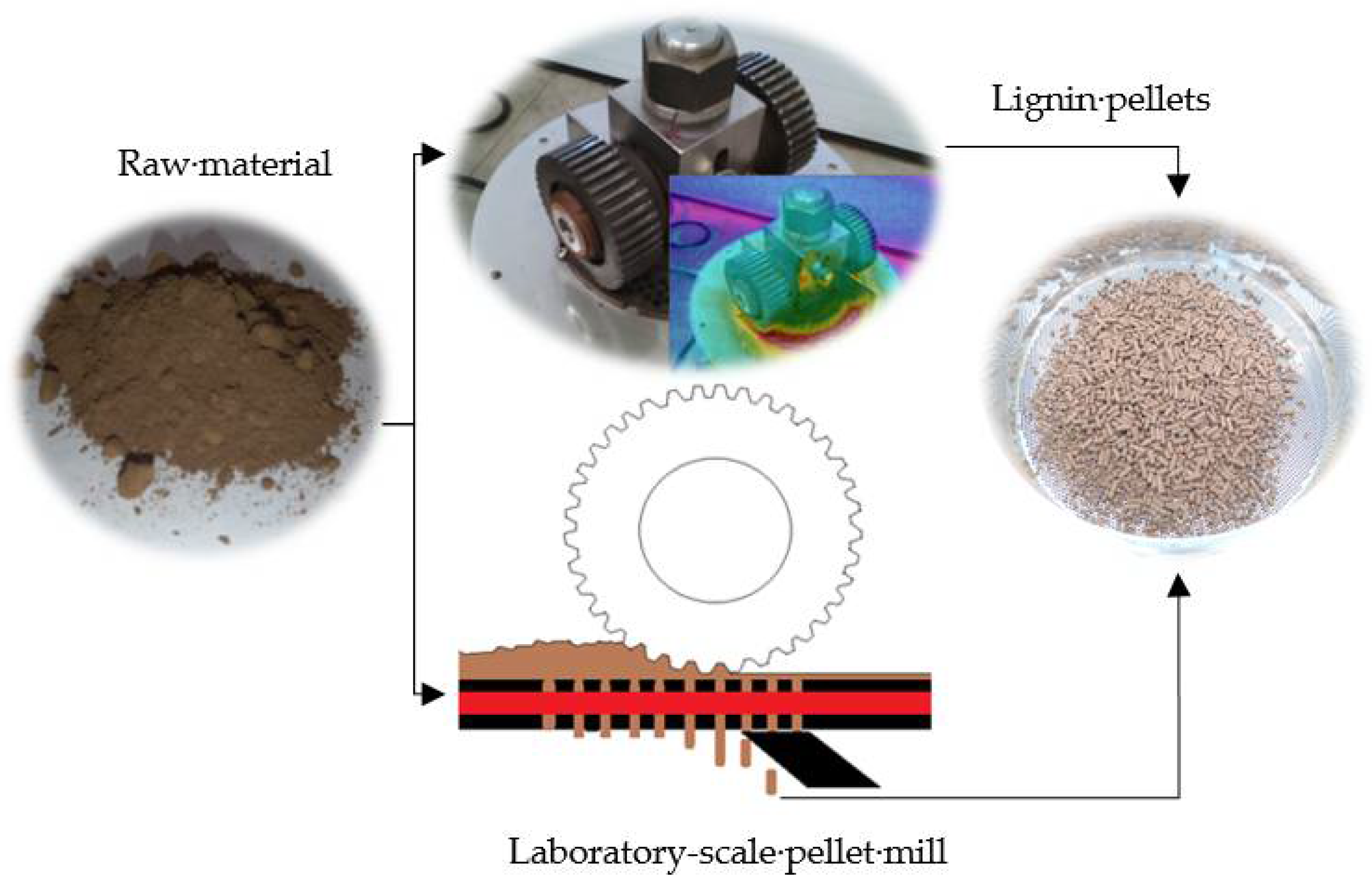

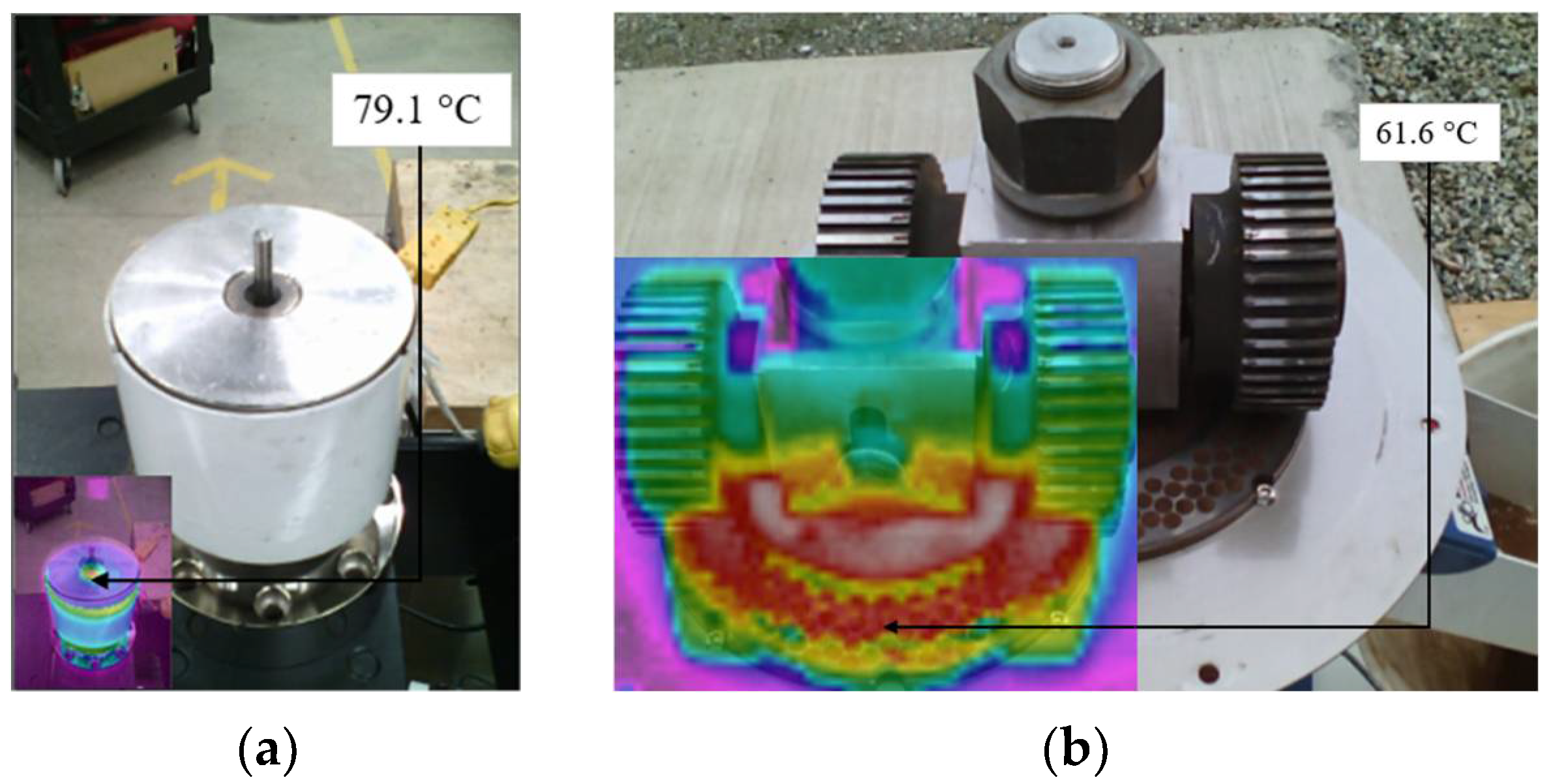
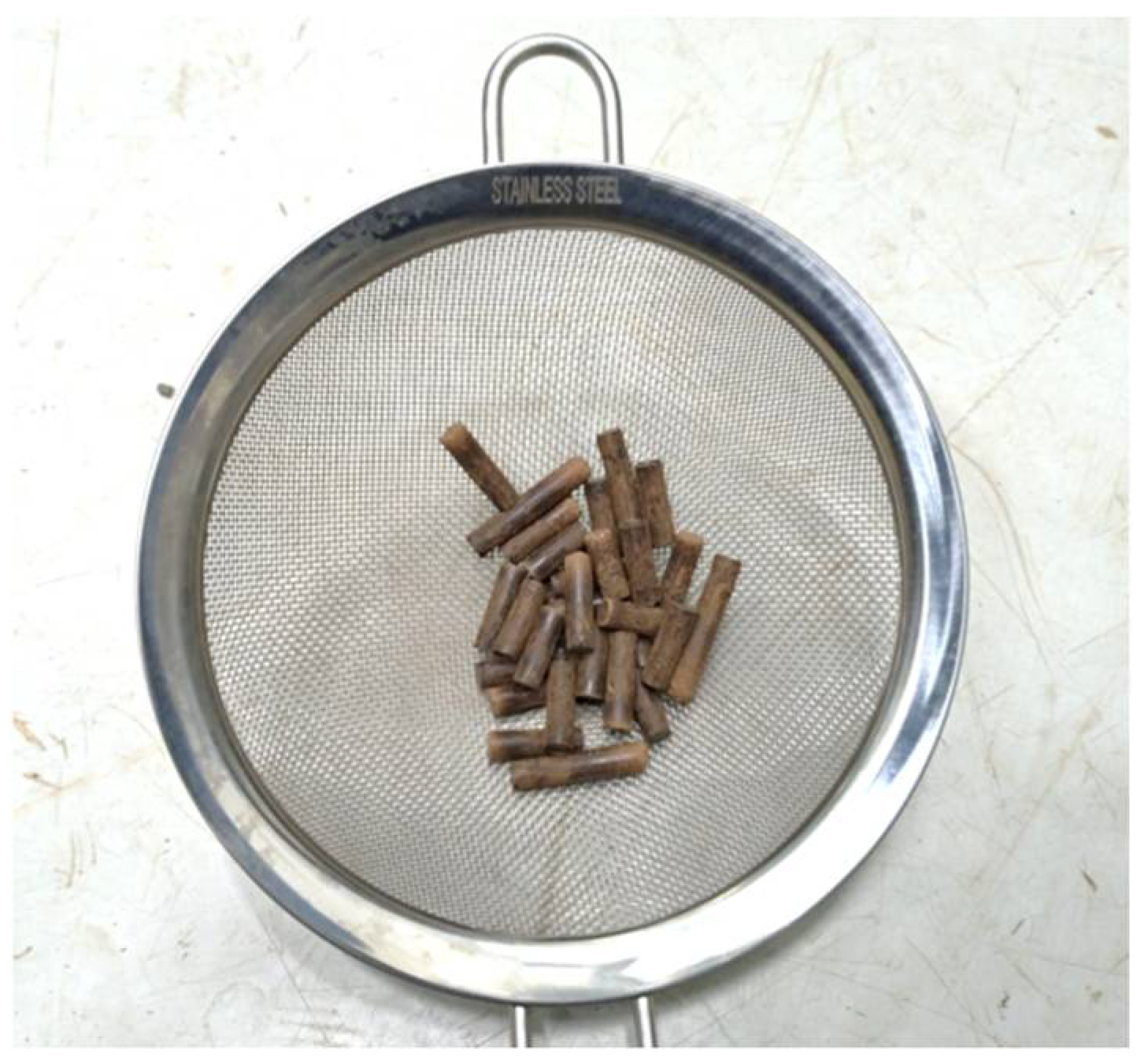
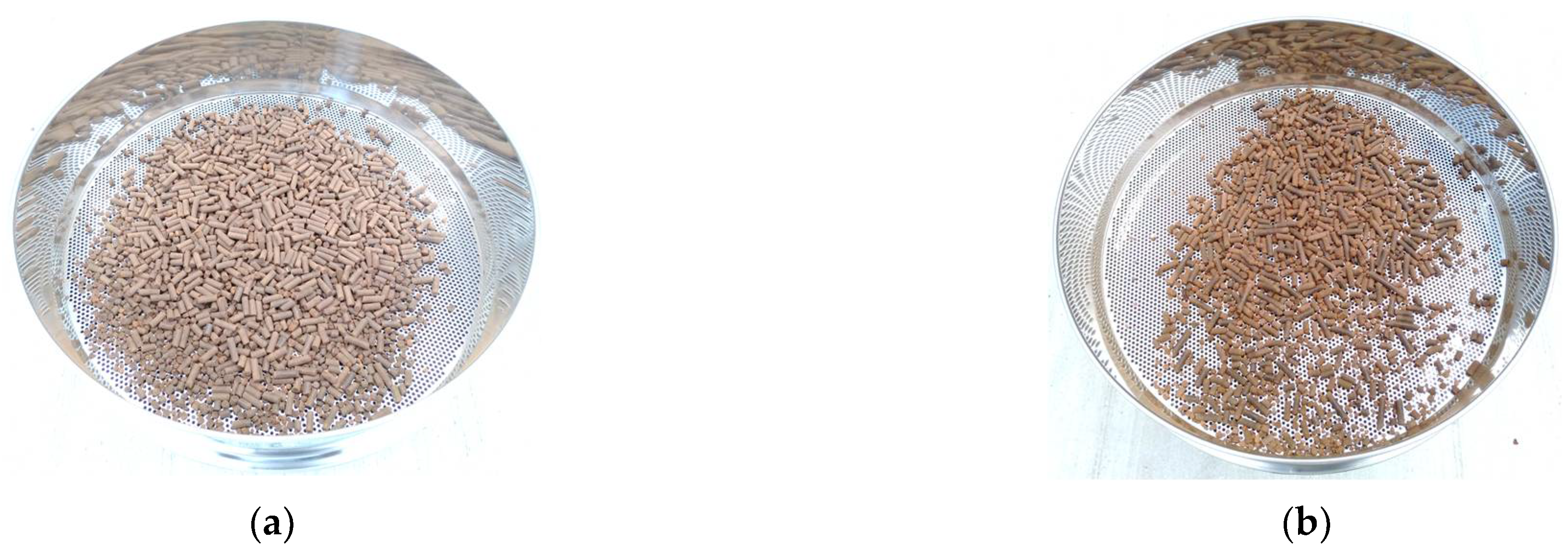

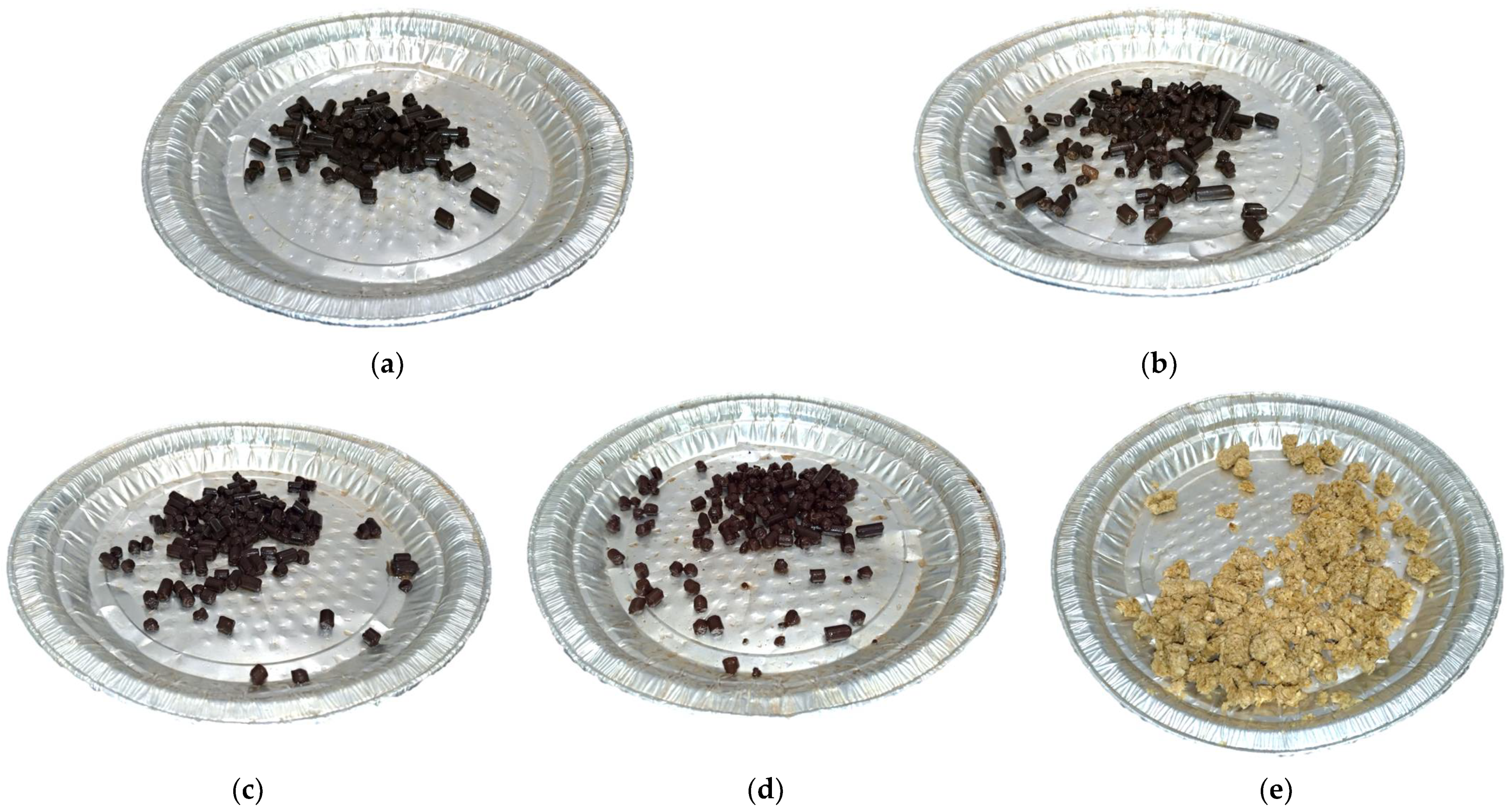
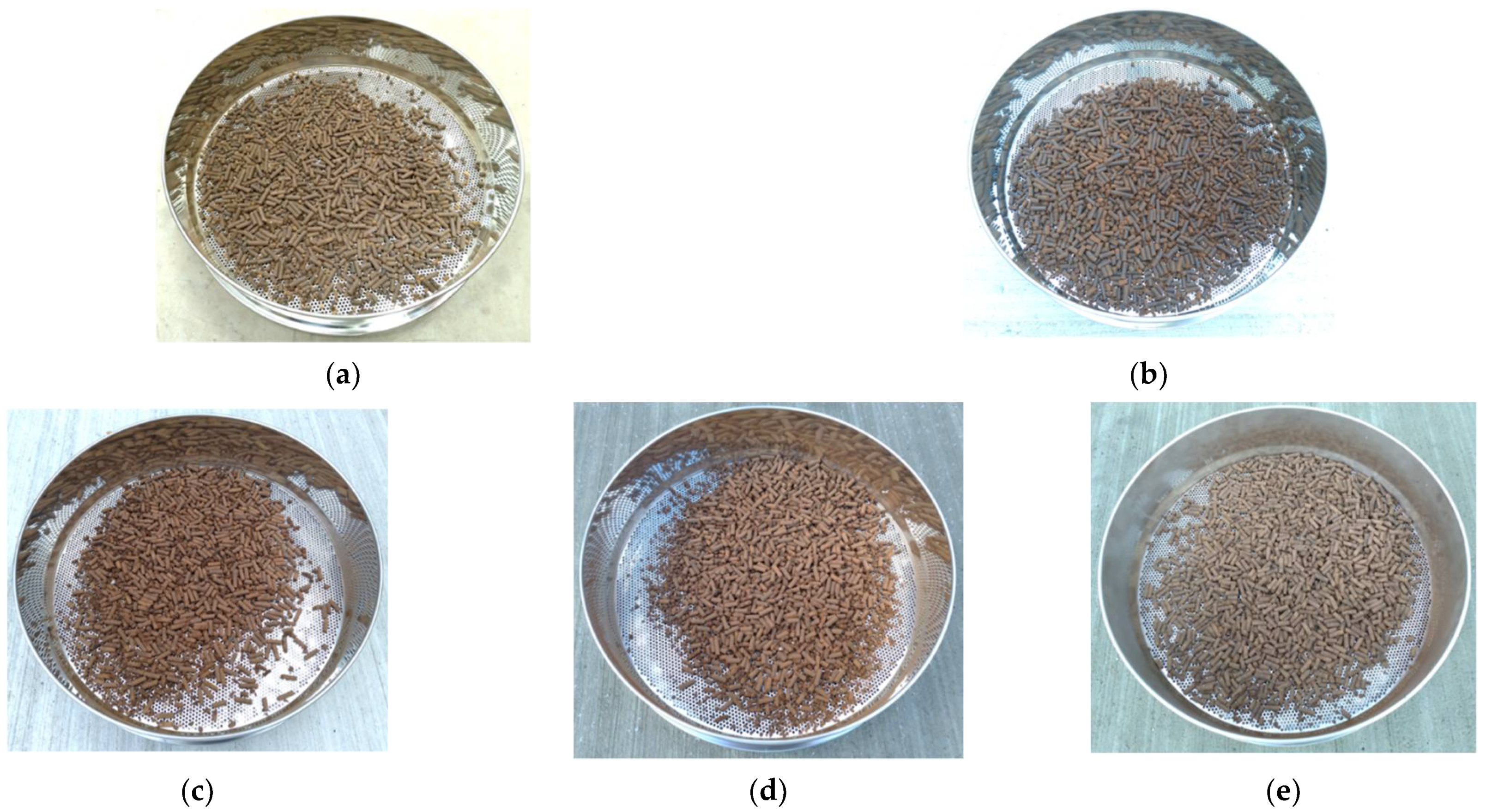
| Property | Poplar Wood Lignin | CANplus Certification | ||
|---|---|---|---|---|
| A1 | A2 | B | ||
| Diameter (mm) | 6.25 ± 0.04 | 6 ± 1 or 8 ± 1 | ||
| Length (mm) | 20.01 ± 4.09 | 3.15 < L ≤ 40 | ||
| Moisture content (%) | 6.14 ± 0.47 | ≤10 | ||
| Mechanical durability (%) | 99.16 ± 0.03 | ≥98.0 | ≥97.5 | |
| Fines content (%) | 0.19 ± 0.14 | ≤1.0 | ||
| HHV (MJ/kg) | 19.26 | ≥16.5 | ||
| Ash content (%) | 1.97 ± 1.16 | ≤0.7 | ≤1.2 | ≤2.0 |
| Property | Poplar Wood Lignin | Softwood Bark | |||
|---|---|---|---|---|---|
| H1 | H2 | H3 | H4 | ||
| Moisture content (%) | 8.01 ± 0.62 | 26.21 ± 1.80 | 30.07 ± 0.42 | 38.83 ± 0.37 | 6.57 ± 0.15 |
| Diameter (mm) | 6.39 ± 0.04 | 6.40 ± 0.05 | 6.40 ± 0.03 | 6.43 ± 0.28 | 6.52 ± 0.07 |
| Length (mm) | 12.47 ± 5.67 | 12.26 ± 5.67 | 13.84 ± 5.45 | 12.71 ± 6.01 | 16.22 ± 3.32 |
| Mass (g) | 0.41 ± 0.21 | 0.45 ± 0.59 | 0.46 ± 0.21 | 0.47 ± 0.27 | 0.55 ± 0.13 |
| Mechanical durability (%) | 94.80 ± 0.28 | 93.78 ± 0.90 | 91.46 ± 1.88 | 88.90 ± 2.01 | 99.48 ± 0.23 |
| Fines content (%) | 1.45 ± 0.11 | 2.90 ± 0.09 | 4.73 ± 1.36 | 9.87 ± 0.66 | 0.17 ± 0.04 |
| HHV (MJ/kg) | 23.17 | 19.57 | 18.87 | 16.06 | 18.34 |
| Ash content (%) | 1.11 ± 0.49 | 1.37 ± 0.11 | 2.55 ± 0.15 | 2.79 ± 0.29 | 1.01 ± 0.40 |
| Property | Poplar Wood Lignin | Softwood Bark | |||
|---|---|---|---|---|---|
| H1 | H2 | H3 | H4 | ||
| Moisture content (%) | 8.01 ± 0.62 | 26.21 ± 1.80 | 30.07 ± 0.42 | 38.83 ± 0.37 | 6.57 ± 0.15 |
| Initial weight before dropped (g) | 47.86 ± 0.06 | 47.27 ± 0.16 | 47.21 ± 0.11 | 47.15 ± 0.13 | 48.98 ± 0.03 |
| Final weight after dropped (g) | 46.08 ± 0.10 | 43.85 ± 0.26 | 41.97 ± 1.46 | 36.94 ± 0.76 | 48.68 ± 0.05 |
| Weight loss (g) | 3.71 ± 0.17 | 7.23 ± 0.38 | 11.11 ± 3.06 | 21.65 ± 1.40 | 0.61 ± 0.17 |
| Property | Poplar Wood Lignin | Softwood Bark | |||
|---|---|---|---|---|---|
| H1 | H2 | H3 | H4 | ||
| Moisture content (%) | 8.01 ± 0.62 | 26.21 ± 1.80 | 30.07 ± 0.42 | 38.83 ± 0.37 | 6.57 ± 0.15 |
| Initial weight before immersion (g) | 10.11 ± 0.03 | 10.23 ± 0.02 | 10.19 ± 0.02 | 10.63 ± 0.02 | 10.10 ± 0.03 |
| Final weight after immersion (g) | 12.30 ± 0.03 | 12.58 ± 0.02 | 12.84 ± 0.08 | 13.70 ± 0.02 | 30.63 ± 0.02 |
| Water absorbed (%) | 21.62 ± 0.15 | 23.05 ± 0.03 | 25.97 ± 0.58 | 28.87 ± 0.21 | 205.64 ± 0.04 |
| Property | Poplar Wood Lignin | Corn Oil | Citric Acid | Glycerol | D-Xylose |
|---|---|---|---|---|---|
| Diameter (mm) | 6.33 ± 0.02 | 6.34 ± 0.03 | 6.32 ± 0.03 | 6.06 ± 0.09 | 6.18 ± 0.08 |
| Length (mm) | 16.82 ± 2.54 | 12.42 ± 3.67 | 19.22 ± 6.11 | 18.40 ± 2.76 | 17.1 ± 4.38 |
| Moisture content (%) | 13.17 ± 0.35 | 8.41 ± 0.14 | 7.09 ± 0.28 | 6.05 ± 0.46 | 9.12 ± 0.41 |
| Mechanical durability (%) | 93.81 ± 1.62 | 93.77 ± 0.97 | 91.20 ± 0.70 | 89.44 ± 1.84 | 94.31 ± 0.48 |
| Fines content (%) | 0.29 ± 0.02 | 0.62 ± 0.09 | 0.88 ± 0.35 | 1.56 ± 0.07 | 0.56 ± 0.06 |
| HHV (MJ/kg) | 22.62 | 27.40 | 22.11 | 23.17 | 22.59 |
| Ash content (%) | 1.58 ± 0.12 | 1.26 ± 0.15 | 1.13 ± 0.15 | 0.94 ± 0.16 | 1.06 ± 0.13 |
| Ultimate analysis | |||||
| Carbon | 53.56 ± 1.25 | 62.20 ± 0.25 | 54.66 ± 0.09 | 55.98 ± 0.43 | 54.24 ± 1.15 |
| Hydrogen | 5.53 ± 0.28 | 6.72 ± 0.09 | 5.25 ± 0.05 | 6.13 ± 0.13 | 5.18 ± 0.14 |
| Nitrogen | 0.00 ± 0.00 | 0.00 ± 0.00 | 0.00 ± 0.00 | 0.00 ± 0.00 | 0.00 ± 0.00 |
| Sulfur | 0.32 ± 0.06 | 0.00 ± 0.00 | 0.15 ± 0.03 | 0.15 ± 0.02 | 0.15 ± 0.02 |
| Property | Poplar Wood Lignin | Corn Oil | Citric Acid | Glycerol | D-Xylose |
|---|---|---|---|---|---|
| Moisture content (%) | 3.90 ± 0.15 | 5.21 ± 0.08 | 7.48 ± 0.12 | 9.23 ± 0.09 | 14.90 ± 0.08 |
| Mechanical durability (%) | 95.70 ± 0.00 | 94.49 ± 0.11 | 91.97 ± 5.08 | 94.67 ± 0.72 | 95.79 ± 0.86 |
| Fines content (%) | 0.51 ± 0.00 | 0.30 ± 0.08 | 0.41 ± 0.25 | 0.44 ± 0.03 | 0.19 ± 0.05 |
| Property | Poplar Wood Lignin | Corn Oil | Citric Acid | Glycerol | D-Xylose |
|---|---|---|---|---|---|
| Moisture content (%) | 2.15 ± 0.04 | 9.78 ± 0.77 | 8.05 ± 0.41 | 10.11 ± 0.60 | 11.99 ± 0.17 |
| Mechanical durability (%) | 97.69 ± 0.09 | 97.07 ± 0.01 | 95.46 ± 1.85 | 96.89 ± 0.44 | 97.66 ± 0.25 |
| Fines content (%) | 0.16 ± 0.00 | 0.32 ± 0.05 | 0.24 ± 0.16 | 0.20 ± 0.00 | 0.13 ± 0.02 |
Publisher’s Note: MDPI stays neutral with regard to jurisdictional claims in published maps and institutional affiliations. |
© 2022 by the authors. Licensee MDPI, Basel, Switzerland. This article is an open access article distributed under the terms and conditions of the Creative Commons Attribution (CC BY) license (https://creativecommons.org/licenses/by/4.0/).
Share and Cite
Rueda, S.J.; Rego de Vasconcelos, B.; Duret, X.; Lavoie, J.-M. Lignin Pellets for Advanced Thermochemical Process—From a Single Pellet System to a Laboratory-Scale Pellet Mill. Energies 2022, 15, 3007. https://doi.org/10.3390/en15093007
Rueda SJ, Rego de Vasconcelos B, Duret X, Lavoie J-M. Lignin Pellets for Advanced Thermochemical Process—From a Single Pellet System to a Laboratory-Scale Pellet Mill. Energies. 2022; 15(9):3007. https://doi.org/10.3390/en15093007
Chicago/Turabian StyleRueda, Sergio Jaimes, Bruna Rego de Vasconcelos, Xavier Duret, and Jean-Michel Lavoie. 2022. "Lignin Pellets for Advanced Thermochemical Process—From a Single Pellet System to a Laboratory-Scale Pellet Mill" Energies 15, no. 9: 3007. https://doi.org/10.3390/en15093007
APA StyleRueda, S. J., Rego de Vasconcelos, B., Duret, X., & Lavoie, J.-M. (2022). Lignin Pellets for Advanced Thermochemical Process—From a Single Pellet System to a Laboratory-Scale Pellet Mill. Energies, 15(9), 3007. https://doi.org/10.3390/en15093007








